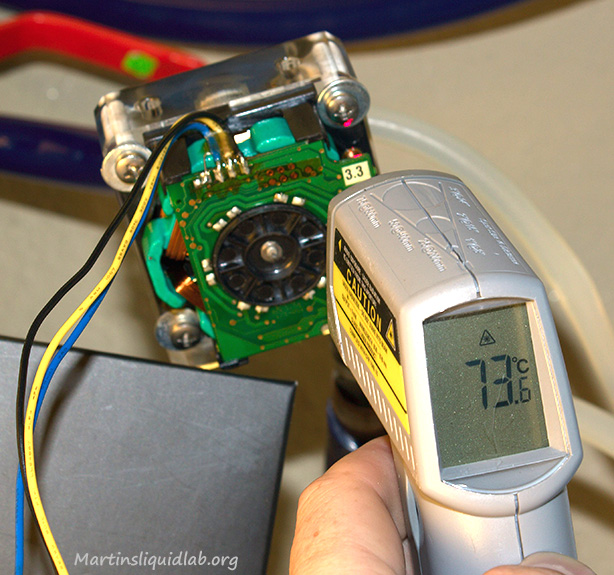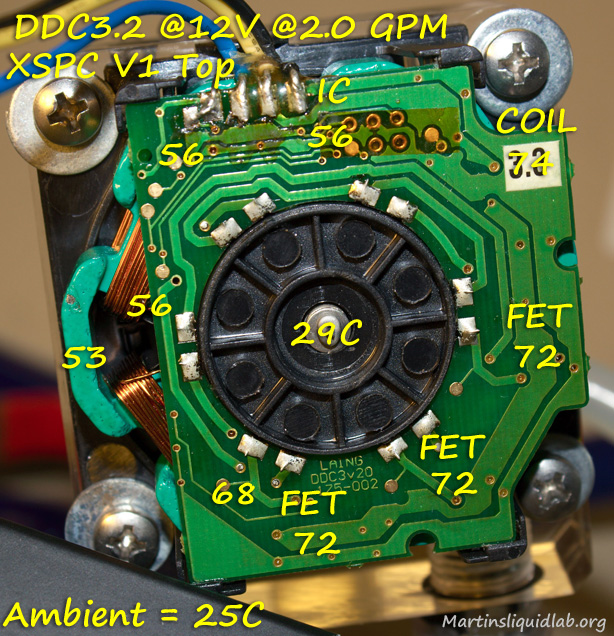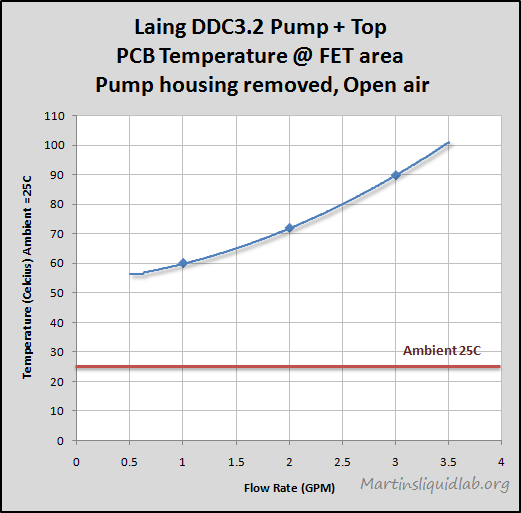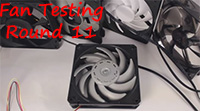If you have owned a DDC series pump (particularly one of the 18W flavors) you’ll know that they tend to get hot to the touch on their bases. In preparation for some evaluation of cooling options on DDC series pumps, I wanted to explore “Where” the heat is coming from in more detail. I needed to install at least one temperature probe, so my question was where?
To run the pump bare with the PCB exposed, I used some hardware (Standoffs+washers) to mount my XSPC V1 DDC top to a Laing DDC 3.2 that I’ve had in my inventory. I have noticed a higher power consumption from the 3.2 vs the newer 3.25 model, so I figure it would make a good worst case / high heat test subject. Measuring the exposed PCB would allow me to see exactly what was creating the heat and have a better sense of where I should place thermal sensors for future cooling tests.
For temperature measurement, I used my Raytek Minitemp Laser thermometer to shoot and scan over the PCB of the pump bottom. It’s not very high in precision, but it is an easy means to scan and measure a large number of surfaces very quickly and find the problem areas.
I also initially set the restriction level on my valved flow meter to 2.0GPM to represent a higher flow/lower restriction condition which has been shown to draw more power from the pump.
 Here you can see the approximate measurement methods used with the laser thermometer.
Here you can see the approximate measurement methods used with the laser thermometer.
And after scanning over the entire surface, this is the approximate temperature grid I was able to measure @ 2GPM:

Center of pump is cool relative to the FET and Coil areas on the right.
Restriction/Flow Rate Influence
While I picked 2 GPM as my mark of lower restriction, I did notice fairly dramatic changes in temperature with differing flow rates and explored that a bit. I was fairly surprised at how temperatures rise with increased flow rate. From pump testing, I was able to see this at a smaller scale via power consumption numbers, but temperatures are more dramatic.
Here are a couple of pictures of the temperature exploration at 3GPM:
 Measuring at 3GPM shows a dramatic increase in temperature.
Measuring at 3GPM shows a dramatic increase in temperature.
 Coil Temp nearly 100C! @ 3GPM
Coil Temp nearly 100C! @ 3GPM
While this isn’t of any high precision or accuracy, this is an approximate relation of the FET area PCB temperature relative to flow rate with the pump casing removed.

FET temperature is very dependent on flow rate.
Low Restriction + Full DDC3.2 Pump Power + Pump Top = High Heat
Links to DDC’s melting down
I thought the following is a good example of the extreme heat causing problems for some folks:
Conclusion
It appears the FETs and coils run the hottest on the pump and the IC is of little interest. Also the center of the pump base is not very representative of the hottest areas. I will see what I can do about placing a probe or two near the FETs and coil area inside the pump casing. A high restriction system at 1GPM only measured roughly a temperature of Ambient +35C while the very low restriction 3GPM condition resulted in almost twice the delta of Ambient +55C. I’m beginning to think heat removal via a heatsink is more important than most people think when running DDC pumps with tops. The factory Laing top will restrict that max flow rate, but once opened up via a pump top…the heat is ON!
This is a bit preliminary, but it may also make more sense to design a balanced system of pumping power vs restriction. Too little restriction under full power is apparently making these DDC pumps with tops heat up, while too much and you could have bleeding problems and reduced thermal performance. Shooting for 1-1.5GPM or so with DDC pumps, may be a good target to keep heat in check.
More testing to come….I will be exploring heatsinks and air flow scenarios soon. I just need to find some fine wire to solder a few probes inside my DDC for testing enclosed.
Cheers!
Martin

Cool article once again Martin!
Hey can you recommend a decent flow-meter I can build into my H20-220 Edge kit?
I’m about to add a GTX560Ti to the loop, which I intend to heavily OC on occasion.
So I’m trying to get my head around all the parts + twks/slight-improvements I’ll want to accommodate for that.
I know rad. is the single-biggest improvement…
But I want to do a bunch of a other little things 1st, & then maybe a rad. too
http://www.xtremesystems.org/forums/showthread.php?p=4863166#post4863166
For a practical meter, I would suggest the Koolance FM17 and the meter frequency adapter if you wanted to read via a motherboard. I don’t have any personal experience, but I’ve read a few others with good comments about them. About $40 for the set:
http://www.koolance.com/water-cooling/default.php?cPath=109_70
I use King Instruments flow meters for testing and have used them in builds, but they are huge in size and not very practical.
That link i provided is dead now, here’s the new one!
http://www.xtremesystems.org/forums/showthread.php?p=4866734#post4866734
Thanks if you can spare some time.
All the best,
Jed
Thanks mate,
RE the list of things I intend to do/buy that I linked to:
http://www.xtremesystems.org/forums/showthread.php?p=4863166#post4863166
For some of the categories i haven’t yet listed specific makes/models.
I don’t suppose you have any suggestions you can offer?
All the best,
Jed
It’s quite amazing that you did a heat test on these particular pumps. Martin, (or anyone) please go to one of the reviews you did here:
http://www.overclock.net/water-cooling/934512-martins-koolance-rp-402×2-rp-452×2-13.html
and you’ll see I made a comment to one of the posters on that review (his name is: adamlau). I made some modiifications to my system to cool down those Laing pumps. At least for now they run much cooler as a result of having them exposed and a dedicated fan blowing cool air underneath them… 🙂
BTW, I was post #123, just in case he needed to know that. Thanks again Martin for all your help in what you do, and I hope this is a slight resolve to this issue until something more permanent can be done to keep these particular pumps running at their coolest temperature… 🙂
I got a mcp 355 pump and I want to turn it into mcp350, I looked the info that you gave about these pumps but my pump’s circuit is a little bit different.
From left to right Grnd(black), power(yellow), blank, rpm(blue) respectively. How can I make it?
I believe that mod from mcp350mcp355 is only doable with the slightly older generation DDC3.1 or DDC3.2. The latest model fix pump is DDC3.15 or DDC3.25 and those are different. Sounds like you have the newer model. The best way to slow it down is to buy a pump speed controller such as the Koolance CTR-SPD10 with a transformer to reduce voltage. They are a bit more expensive but they are made to handle pumps and can actually increase voltage a bit too which fan controllers can’t do. You could also try using a good fan controller capable of 30w per channel, but be careful about not bumping the knob too low or the pump won’t run or start. It is also a really heavy load so most fan controllers can struggle running lower volts and can get really hot. Need to watch fan controller temps a bit and may need to add a fan to cool controller.
Thanks for the answer. But I found something weird. I’m pretty sure that my pump’s pcb is same as swiftech’s mcp35x so I’m planning to solder a wire to blank place to use pwm. What do you think?
Also I’m using my pump with Xspc res top so it’s running really hot, moreover pump’s pcb is burned in some places (small burn traces) but pump is still working. your suggestion is a bit expensive to me, Koolance controller is pricy and there is no sutable place for it in the case. High-power capable fan controllers are tricky and fan type cables are thin and can be a problem for the current. Is there another way to fix it 10 volts that is enough for me, a resistance to power cable for example…
I haven’t tried it myself, but someone on XS said they tried to add a PWM wire to the PCB and it didn’t work. They do look the same but I think there is some sort of programming difference. One cheap way to reduce heat is to slow flow rate down some via ball valve, but it won’t reduce noise.
You could also try an ordinary fan controller if you already have one and just partially lower voltage and see how it does beat wise. The more you lower the more stress on the controller, but maybe 10v is enough. Not sure of any other low cost options.
Very bad to hear that, so pwm option is out. I wil try the fan controller. I have to convert molex socket to the fan socket and attach the pump to fan controller. Thanks for the answers again, and by the way I know you’re tired of testing rads, but do you think to test 140 or 180 type rads?
I may later but the short term plan is focusing on kit testing and reviews which take quite a bit of time. My rad bench can handle up to 140×3 though so it’s set up for 140s. Just need the time..:)
[…] […]